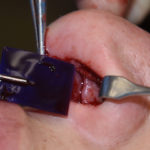Most rhinoplasty surgeries done today use an open approach. By degloving the nasal tip skin through a columellar skin incision, the exposure to see the underlying cartilage structure offers more consistent and controlleable structural changes. While most of the attention focuses on the incision located at the midportion of the columellar skin, the true tradeoffs for making this open approach are more occult.
When the skin is lifted off the tip of the nose, scar tissue will develop from the middle vault across the tip down to the base of the columella. Scar tissue notoriously contracts as it heals. By doing so a scar band develops which can contribute to a nasal tip deformity marked by a rounded and less defined tip and less tip projection. This process is magnified if additional dissection is done to resect the caudal end of the septum or trim the distal ends of the upper lateral cartilages, disrupting a large number of suspensory ligaments and creating even more scar.

Like an internal tentpole, the columellar strut provides support to the tip that is more than adequate to resist contracture deformities. It can also be used to help build up a weak tip for more projection or refinement or, increase or decrease tip rotation. When attached to septal extension grafts, it a very effective component to lengthening the short or over rotated nose. Its effectiveness has made the columellar strut concept a staple of modern day rhinoplasty.

Columellar strut are the most common graft used in open rhinoplasty. Since a septoplasty is frequently performed as part of many nasal procedures, good pieces of cartilage can be easily obtained. At the least, columellar struts help prevent nasal tip distortion. When used with other graft techniques, they can help actually increase tip projection or derotate the tip.
Dr. Barry Eppley
Dr. Chris Ueno
Indianapolis, Indiana


